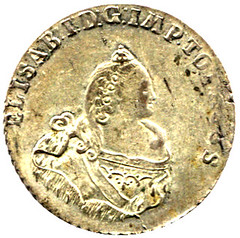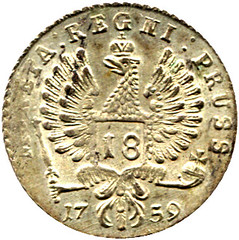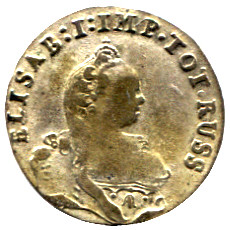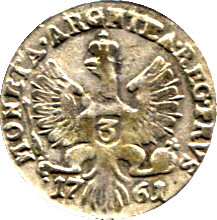
PREV ARTICLE
NEXT ARTICLE
FULL ISSUE
PREV FULL ISSUE
COINS OF THE SEVEN YEAR'S WAR
Here is the press release for a large collection of coins of Frederick II in the upcoming auction of the Tempelhofer Münzenhaus / Berlin, on April 6, 2017. To conserve space, I've only illustrated two of the coins.
-Editor
The Russians in Koenigsberg: a numismatic testimony to the Seven Years’ War In the upcoming auction of the Tempelhofer Münzenhaus / Berlin, on April 6, 2017, a large collection of coins of Frederick II will be auctioned off. They include a comprehensive series of Russian coins from East Prussia. We are telling their story. As a matter of fact, the Seven Year’s War (1756-1763) might be understood as the first global war in history: All major European powers were involved. On the side of Prussia, there were England and Portugal while on the side of the House of Habsburg, there were France, Russia and Sweden; and these were only the three most significant participants. Their campaigns were not restricted to the European territory but infringed North America, India and the Caribbean. Nevertheless, the decision was made in Europe without involving any army.
East Prussia Geographically speaking, it was an exclave in the Polish Kingdom (fig. 1). East Prussia only was not subject to the supremacy of the Polish ruler because he had waived his sovereign rights in 1657. Therewith, the East Prussian ruler was autonomous and free to place a royal crown on his head. This in no way changed anything about the two weak spots of his East Prussian rule: Located far away from the ancestral homeland, the territory was difficult to defend. And the Polish would have loved to incorporate it into their own empire again.
And what did the Russians want in East Prussia? Thus, East Prussia was no mere strategic goal when the Russian army, led by General Apraksin, attacked on July 1, 1757. He won the Battle of Gross-Jaegersdorf, but could not take advantage of his victory. Also his lines of supplies were too long. As a result, the Russian main body was forced to retreat. Already in the spring of the following year, though, it attacked another time. The Battle of Zorndorf was a horrible bloodbath and modern historians still wonder who has won exactly. The Prussians lost 13,000 men, and the Russians 18,000! No wonder, then, that Federick’s situation became increasingly threatening. In the Battle of Kunersdorf, he suffered a devastating defeat. Berlin wasn't taken only for the fact that the allies were interested in other things. Elizabeth wanted East Prussia, and that became the place where the Russian administration took residence.


18 groeschers 1759, Koenigsberg.
Russian coins for East Prussia And so, the Russians made good use of the Koenigberg Mint to strike coins for East Prussia between 1759 and 1762. The denominations matched the local ones. They consisted of third talers (fig. 3), sixth talers (fig. 4), 18 groeschers, also called tympf (fig. 5), 6 groeschers or szostak (fig. 6), 3 groeschers or duettchen (fig. 7), 2 groeschers (fig. 8), groschen (fig. 9), and schilling (fig. 10). The coins’ design of course changed. From the third taler down to the 3 groeschers, on the obverse we see the bust of Tsarina Elizabeth I with a Latin legend (in translation): Elizabeth I by the grace of God Empress of all Russia. The 2 groeschers, in contrast, only depicts the Russian double eagle with the Latin wording (in translation): silver coin. The smallest denomination, the schilling of which three made a groschen, shows an entwined monogram consisting of E and P for Elizabeth Petrovna (= Elizabeth, daughter of Peter). The reverse, on the other hand, remains Prussian: It features the crowned eagle with scepter and Imperial orb. Furthermore, every denomination clearly states its value, and the groschen even mentions explicitly that it was a coin of the Kingdom of Prussia (Moneta Regni Prussiae).


3 groeschers 1761, Moscow
Coin imports from Moscow How popular these coins were among the ordinary people becomes clear by the fact that those public counterfeiters, acting on behalf of king Frederick II, produced imitations of the tympf of 18 groschens (fig. 11), but of course with a considerably reduced silver content. These Berlin imitations are recognizable by their obverse legend. Instead of the usual RUSS, they end with RUSSIA or, as in the present case, with RUSSIAE.
Heaven intervenes in favor of Frederick Her heir was Peter III, an ardent admirer of the Prussian King. Already as Tsarevitch, he maintained an extensive exchange of letters with Frederick. He possessed a guard of German soldiers who had been trained according to the Prussian model, and he loved to command it while wearing a Prussian uniform. When the war had broken out, Peter had already tried to stop his aunt from attacking Prussia. Now, he possessed the power to do what he deemed right. And this meant immediate peace negotiations.
East Prussia and the Treaty of Saint Petersburg
A decision of historical significance
And East Prussia? The Numismatic Bibliomania Society is a non-profit organization promoting numismatic literature. See our web site at coinbooks.org. To submit items for publication in The E-Sylum, write to the Editor at this address: whomren@gmail.com To subscribe go to: https://my.binhost.com/lists/listinfo/esylum All Rights Reserved. NBS Home Page Contact the NBS webmaster 
|